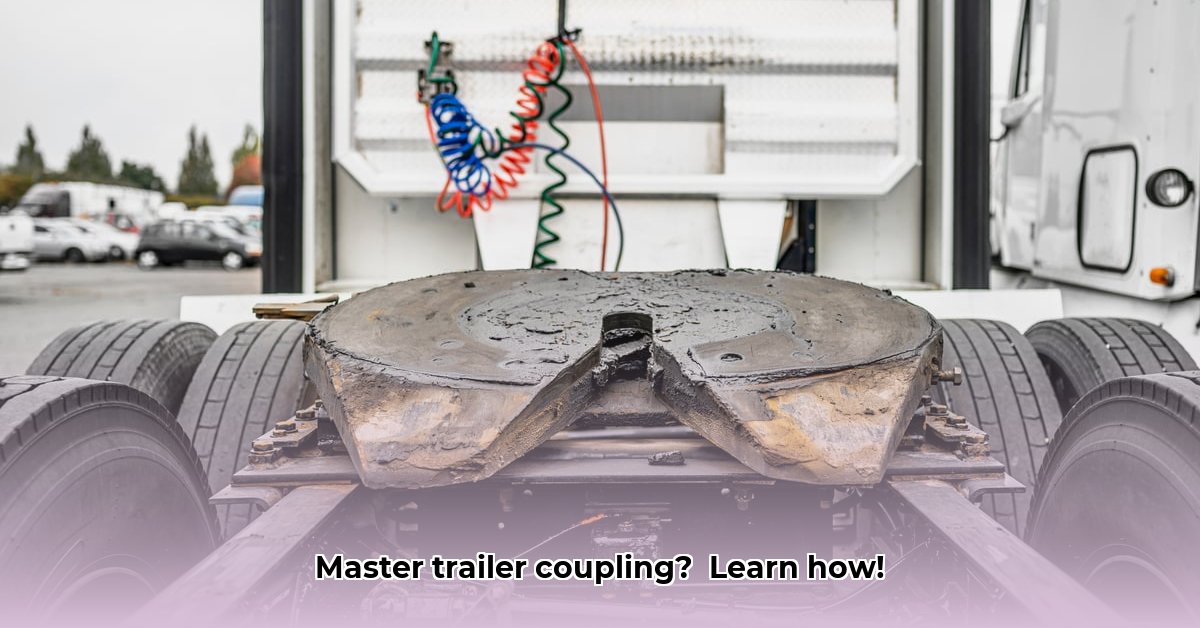
Mastering the Tractor-Trailer Coupling System: A Comprehensive Guide
Hooking up a tractor-trailer can seem daunting, but with the right technique and attention to detail, it becomes a routine process. This guide provides a step-by-step approach, incorporating safety measures and best practices for both drivers and fleet managers. We'll cover pre-trip inspections, the coupling and uncoupling procedures, weight distribution considerations, troubleshooting, and advanced techniques for optimizing fleet operations. For more information on leasing costs, check out this helpful resource: lease costs.
Pre-Coupling Inspection: Prioritizing Safety
Before starting, a thorough pre-coupling inspection is paramount. This preventative step significantly reduces the risk of accidents and operational issues. This isn't just about checking; it's about ensuring your coupling system is ready for safe operation.
- Fifth Wheel Inspection: Examine the fifth wheel for any signs of damage, cracks, or excessive wear. Ensure the locking jaws operate smoothly. (The fifth wheel is the mechanism on the tractor that connects to the trailer.)
- Trailer Landing Gear Check: Verify the trailer's landing gear is fully retracted and securely locked. (Landing gear are supports that hold the trailer when it's not connected to a tractor).
- Air and Electrical Line Inspection: Carefully inspect all air and electrical lines for damage, kinks, or loose connections. Ensure all connections are clean and secure. (Air lines provide air pressure for brakes; electrical lines power lights and other trailer components.)
"A pre-trip inspection is not just a checklist; it’s a commitment to safety," says Captain John Miller, Safety Director at American Trucking Association. "Taking those few extra minutes to inspect your equipment can prevent significant problems down the road."
Aligning for a Perfect Fit: Precise Tractor-Trailer Positioning
Precise alignment is crucial for a smooth, stress-free coupling. Improper alignment can lead to damage and difficulty connecting the kingpin.
- Back Slowly and Carefully: Use your mirrors to guide your tractor's backward movement toward the trailer. Maintain a slow, controlled speed.
- Aim for Centered Alignment: Ensure the tractor's fifth wheel is directly over the trailer's kingpin. Minor adjustments may be necessary. (The kingpin is the vertical pin on the trailer that fits into the tractor's fifth wheel).
- Visual Confirmation: Before proceeding, get out and visually confirm the perfect alignment. Precise positioning prevents damage to the coupling system.
Coupling the Tractor and Trailer: A Step-by-Step Process
This section outlines the step-by-step procedure for connecting the tractor and trailer. Following these instructions precisely ensures a secure and safe coupling.
- Engage the Fifth Wheel: Raise the locking jaws on the fifth wheel. You should hear a distinct click when they are fully engaged.
- Guide the Kingpin: Slowly back the tractor until the kingpin firmly seats into the fifth wheel opening. If any resistance is felt, stop to realign.
- Retract the Landing Gear: Double-check that the trailer's landing gear is fully retracted.
- Connect Air and Electric: Firmly connect all air and electrical lines.
- Verify Connections: Thoroughly inspect all connections for tightness and security. This step ensures the system's proper function.
Why is this final verification so important? "A seemingly small leak can quickly escalate into a major safety hazard," notes Sarah Chen, Lead Engineer at Trailer Dynamics Inc. "Always double-check your connections to prevent potential accidents."
Uncoupling: Safely Disconnecting Your Rig
Uncoupling requires careful attention to detail, ensuring the safety and stability of both the tractor and the trailer.
- Disconnect Air and Electric: Carefully and completely disconnect all air and electrical lines. Remember to follow safety protocols for disconnecting pressurized air lines.
- Extend the Landing Gear: Fully extend and lock the trailer's landing gear to support the trailer's weight.
- Release the Fifth Wheel: Carefully release the fifth wheel's locking mechanism, ensuring the locking jaws are fully open.
- Pull Away Slowly: Gently pull the tractor forward to detach from the trailer. Avoid sudden movements.
- Final Inspection: After separating, conduct a final visual inspection of both the tractor and trailer.
Weight Distribution and Safety: Ensuring Stability
Maintaining proper weight distribution is essential for safe and efficient operation. Overloading or uneven weight distribution can significantly impact stability and handling. Always refer to your vehicle's weight limits and relevant regulations.
"Weight distribution is not just about legal compliance; it's about the safety and stability of your operation," emphasizes Robert Garcia, Transportation Consultant at the National Transportation Safety Board. "Following guidelines ensures a smoother ride and safer operation."
Variations in Coupling Systems: Adapting to Different Configurations
Coupling systems vary, depending on the tractor and trailer types. Always consult your vehicle's owner's manual for specific instructions and diagrams.
Troubleshooting Common Coupling Issues: Addressing Problems Effectively
If problems occur, address them promptly and correctly. Misalignment can often be rectified by careful repositioning. Loose connections should be promptly tightened and inspected. For persistent issues, call for professional assistance.
Advanced Considerations for Fleet Managers: Optimizing Operations
For fleet managers, safety and efficiency are paramount. Regular driver training, standardized checklists, and investing in advanced coupling technologies all improve operations. Telematics can monitor performance and driver behavior, providing valuable data to optimize fleet safety and efficiency. Regular maintenance and inspections are non-negotiable.
How to Prevent Tractor-Trailer Coupling Accidents: A Focus on Safety
This section reinforces the crucial aspects of safe coupling practices to reduce the risk of accidents.
Key Takeaways:
- Pre-trip inspections are crucial for accident prevention.
- Precise alignment prevents damage and ensures safe connection.
- Verify air brake and electrical connections and ensure a sound and leak-free system.
- Slow and deliberate movements are vital.
- Post-coupling checks prevent potential hazards.
Remember, safe coupling practices are paramount. Thorough inspections, precise procedures, and a commitment to safety are the cornerstones of preventing tractor-trailer coupling accidents. Prioritizing safe operations benefits everyone.